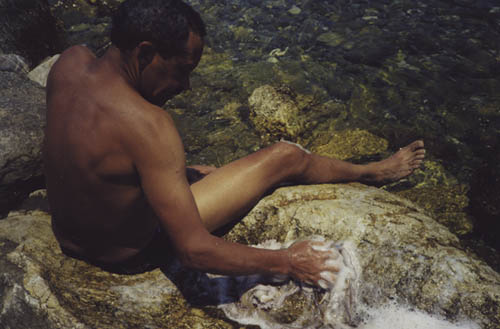Semicircular and built at the base of a large rock
 [Image: Jack Whitten prepping octopi on the rocky coast; photo via Art Lies: A Contemporary Art Quarterly].
[Image: Jack Whitten prepping octopi on the rocky coast; photo via Art Lies: A Contemporary Art Quarterly].Jack Whitten is an octopus-hunter—or octopus fisherman, we might say, both more and less accurately. This activity, which he performs without the use of air tanks, requires a surprisingly niche architectural knowledge: "Millions of years ago," Whitten writes, "the octopus had a shell, but slowly they lost it through the evolutionary process. Since then, the octopus is always looking for a home. They occupy the abandoned shells of other sea creatures, cans and car tires or make their own houses, which I call 'octopus architecture.'"
 [Image: Jack Whitten prepping octopi on the rocky coast; photo via Art Lies: A Contemporary Art Quarterly].
[Image: Jack Whitten prepping octopi on the rocky coast; photo via Art Lies: A Contemporary Art Quarterly].The trick, Whitten says, is to lure the octopus out of its site of undersea domesticity using nothing but a white handkerchief; after all, "they are addicted to the color white like a bull is to red. They can’t control themselves. Thus, I always keep a white handkerchief tucked into my wetsuit, which I use to seduce them from their lair."
Until that point, however, the hunt is as much about stalking architectural signs across the seafloor as it is about locating an animal's body:
- When hunting for octopus, one must learn to recognize the morphology of the bottom of the sea. Octopus prefer a specific setting identifiable by a certain quality of stones, sand and plant life. Octopus architecture is unique, constructed with stones, shells, wood, bits of sea glass or anything available for building a nest. And of course, they prefer white stones. The nest is always semicircular and built at the base of a large rock, which serves as an anchor. They burrow a tunnel deep beneath the rock, usually with an exit for escape if attacked. The semicircular structure is built five, six or eight levels of rock high depending on the size of the octopus. It is masonry without mortar: closely fitted, tight and fortified. Most of the time I only see the architecture.
(Thanks to Alexis Madrigal for sending this link long ago!)





Comments are moderated.
If it's not spam, it will appear here shortly!
Post a Comment